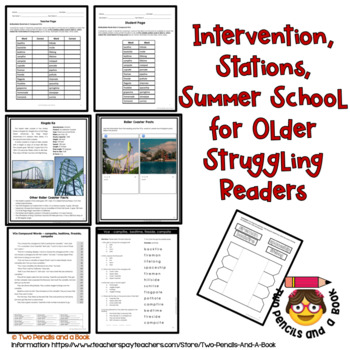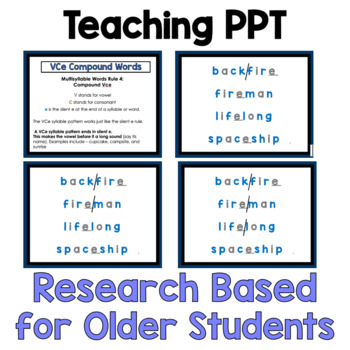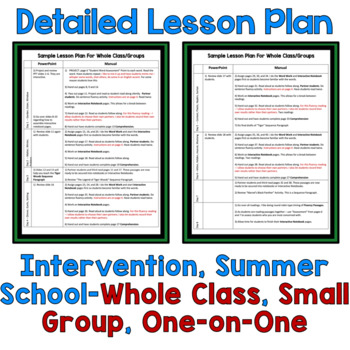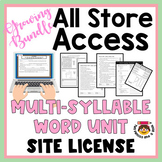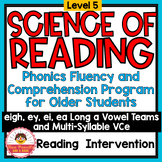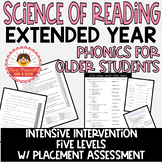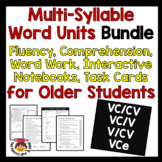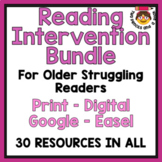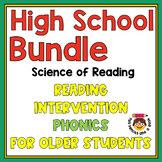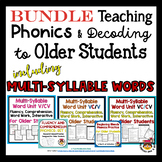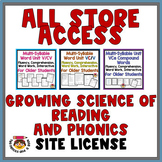Multi-Syllable Words VCe Compounds Science of Reading Phonics for Older Students
- Zip
What educators are saying
Also included in
- GIANT Growing Bundle of every Science of Reading Multi-Syllable Word Phonics resource I add to my store - print and digital. This phonics work includes reading comprehension, fluency, word attack, syllabication and more - all embedded into research-based phonics programs.*********ENTIRE STORE ACCESSPrice $84.50Original Price $122.68Save $38.18
- Giant Intervention Bundle. High interest - low level reading comprehension, fluency and phonics program for secondary students. This program is perfect for older struggling readers. Print and digital phonics, multi-syllable word work, intervention reading comprehension, fluency and word work.DownloPrice $228.65Original Price $378.78Save $150.13
- Bundle of Science of Reading Phonics Fluency and Reading Comprehension for Older Students - print and digital. This phonics work includes reading comprehension, fluency, word attack, and more - all embedded into research-based phonics programs. This resource has imperative turnkey Explicit DirectPrice $7.22Original Price $9.45Save $2.23
- Bundle of Science of Reading Phonics Fluency and Reading Comprehension for Older Students - print and digital - perfect for intensive intervention, extended year or summer school. Begin with the placement assessment then use this turnkey resource to move struggling readers to reading proficiency.Price $43.08Original Price $67.42Save $24.34
- GIANT INTERVENTION Bundle. This is a No Prep - Reading Intervention Program for older struggling readers. Aligned with the science of reading.This program helps students learn multi-syllable words through phonics practice. These units concentrate on VC/CV Multi-Syllable WordsVCe compound wordsVC/VPrice $18.70Original Price $31.50Save $12.80
- Giant 31 resource bundle that includes high interest low level reading, reading comprehension, word work, phonics all for older struggling readers. This is the perfect resource for class-wide, small group, individual or cluster reading intervention program.This summer intervention bundle contains diPrice $62.89Original Price $124.04Save $61.15
- GIANT INTERVENTION Bundle. This is a No Prep - Reading Intervention Program for older struggling readers. Aligned with the science of reading.This program helps students learn multi-syllable words through phonics practice. These units concentrate on VC/CV Multi-Syllable WordsVCe compound wordsVC/VPrice $20.27Original Price $36.50Save $16.23
- Phonics for older students based on the Science of Reading. GIANT 14 resource INTERVENTION Bundle. This is a No Prep - Reading Intervention Program for older struggling readers. Aligned with the science of reading.This program helps students learn multi-syllable words through phonics practice. ThesPrice $28.69Original Price $51.16Save $22.47
- GIANT Growing Bundle of every Science of Reading Phonics resource I add to my store. This phonics work includes reading comprehension, fluency, word attack, syllabication and more - all embedded into research-based phonics programs.*********ENTIRE STORE ACCESS BUNDLE**********Full and complete StorePrice $137.70Original Price $209.52Save $71.82
Description
This is a No Prep - Reading Intervention Program for older struggling readers that incorporates the science of reading research. Google Slides link included. This program helps students learn multi-syllable words through phonics practice. This unit concentrates on VCe compound words. It contains fluency, comprehension, word work, a teaching Powerpoint, interactive workbook pages, assessments and more. This entire unit is research-based, and the research is included.
This program works for resource, whole class, RTI, summer school, intervention, and more. If you are using this program with more than one student – partner up. Partnering students is engaging and lets everyone participate. This program helps students build confidence while reinforcing learning; additionally, by reading, tracking and reading again, student exposure to each passage is maximized.
Table of Contents
Fluency Research page 3
Fluency Instructions and Optional Instructional Script page 4
Multisyllabic Word Reading Research page 5
Pre-Assignment Assessment Teacher Page page 6
Pre-Assignment Assessment Student Page page 7
VCe Teaching pages page 8
backfire – fireman - lifelong – spaceship: Poster or Notebook Page page 10
Word Work page 11
Sentence Fluency page 12
Fluency Passage page 13
Fluency Passage Comprehension Page page 14
Interactive Notebook Page page 15
VCe Teaching pages page 16
hillside – sunrise – flagpole – pothole: Poster or Notebook page page 17
Word Work page 18
Sentence Fluency page 19
Fluency Passage page 20
Fluency Passage Comprehension Page page 21
Interactive Notebook Page page 22
Kingda Ka and Roller Coasters Assignment page 23
Kingda Ka Assignment page 24
VCe Teaching pages page 25
campsite – bedtime - campfire - fireside: Poster or Notebook page page 26
Word Work page 27
Sentence Fluency page 28
Fluency Passage page 29
Fluency Passage Comprehension Page page 20
Interactive Notebook Page page 31
VCe Teaching pages page 32
cupcake – inside – springtime – homemade - pancake page 33
Word Work page 34
Sentence Fluency page 35
Fluency Passage page 36
Fluency Passage Comprehension Page page 37
Interactive Notebook Page page 38
Write a Paragraph CVe Words page 39
Answer Keypage 40
Multisyllabic Word Reading Research
To progress in reading, students must have strategies for decoding big words. From fifth grade on, the average student encounters about 10,000 new words each year. Most of these words are multisyllabic. (Nagy and Anderson 1984).
It is helpful for students to be familiar with the common rules for syllable division. Knowing these rules and being able to apply them flexibly will help students decode longer multisyllabic words. (Carreker 2005; Henry 2010b)
According to Shefelbine and Calhoun 1991, “Low decoders, correctly pronounced fewer affixes and vowel sounds, disregarded large portions of letter information and were two to four times more likely to omit syllables.”
Several studies have shown that teaching students strategies for decoding longer words improves their decoding ability. (Archer et al. 2006; Archer 2018.)
Recognizing a Decoding Problem Symptoms:
- Guesses at words from context
- Avoids sounding out new words
- Confuses similar sounds, symbols, and/or words
- Inaccurate reading of nonsense words or words out of context
- Inadequate sight word vocabulary
- Tires easily, looks away, is easily frustrated, hates to read
These strategies build word recognition and build strong readers:
- Phonemic Awareness
- Vocabulary/Morphology
- Fluency
Teaching Syllabication
- Syllabication instruction teaches a struggling reader strategies to decode multi-syllable words quickly.
- Students learn to systematically break a multisyllable work into small manageable syllables, identify the vowel sounds within each syllable and “sound out” the word syllable by syllable.
- As students progress through the lessons, they will internalize the process and apply it easily and effortlessly.
- They will become faster, more efficient and fluent readers who comprehend at a higher level.
Fluency Research
To be considered “on level” in reading fluency, students should be able to read aloud an unrehearsed passage, (i.e., either narrative or expository, fiction or non-fiction that is 200 to 300 words in length) from a grade-level text, with at least 95% accuracy in word reading. As students read aloud, their reading should sound as effortless as if they were speaking (Hasbrouck & Glaser, 2012.) This does not come easily for some students, which is why fluency practice is so essential.
In order to be considered fluent readers, students in grades 9 through 12 should be able to correctly read 150 words per minute (Hasbrouck & Tindal, 2006). In 2006 and again in 2010, Hasbrouck and Hasbrouck and Tindal (respectively) put forth that “[i]t is sufficient for students to read unpracticed, grade-level text at the 50th percentile of oral reading fluency norms” and that “…teachers do not need to have students read faster because there is no evidence that reading faster than the 50th percentile increases comprehension.” See chart below.
The best strategy for developing and improving reading fluency is to provide students with many opportunities to read the same passages orally several times. These exercises provide such opportunities. On each passage, there is space for reading fluency calculations. The best part is that the passages are quick and make it easy for students to read aloud repeatedly – and often – without taking up a lot of valuable classroom time. The activities can also be spread over several days.
Intervention: Multi-Syllable Word Unit for Older Students VC/CV - Fluency Plus
Multi-Syllable Word TASK CARDS for Older Students VC/CV
Intervention: Multi-Syllable Word Unit for Older Students V/CV - Fluency Plus
Multi-Syllable Word TASK CARDS for Older Students V/CV
Multi-Syllable Word TASK CARDS for Older Students VC/V
Intervention: Multi-Syllable Word Unit for Older Students VC/V - Fluency Plus


